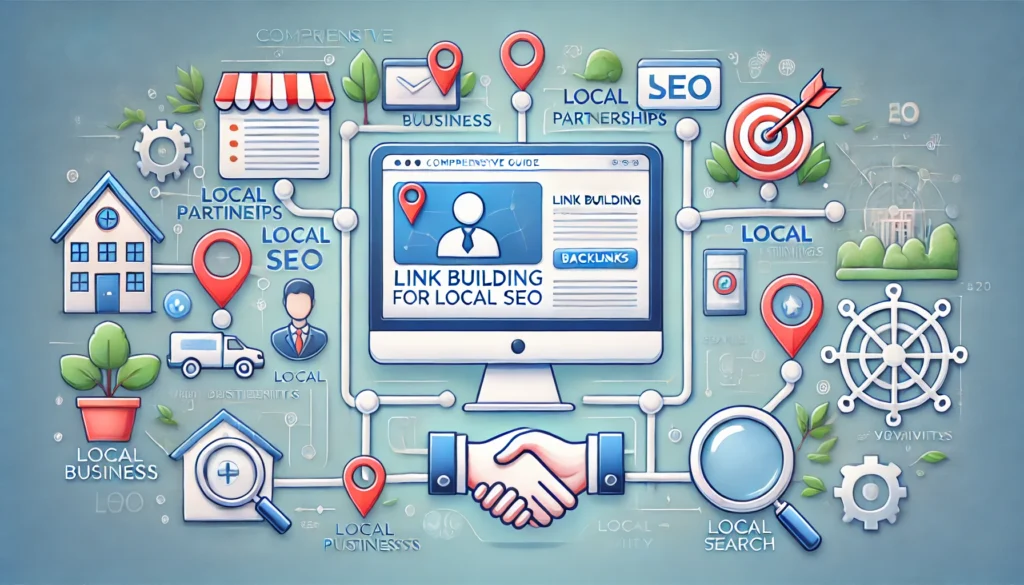Table of Contents
ToggleOverview of LinkBuilding
Link building is a fundamental SEO strategy involving acquiring hyperlinks from other websites to your own. These hyperlinks, commonly known as “links,” are ways for users to navigate between pages on the internet. Search engines use these links to crawl the web, discover new pages, and determine how well a page should rank in their results. The significance of link building in SEO strategies stems from its ability to enhance domain authority, drive referral traffic, and ultimately increase the search engine rankings of a website. High-quality links from reputable sites signal to search engines that your content is valuable and trustworthy, which is crucial for improving your site’s visibility.
Context for 2024
As we move into 2024, the landscape of SEO and link building continues to evolve due to several factors. Advances in search engine algorithms increasingly favor quality over quantity, pushing the costs of acquiring high-quality links higher. Additionally, the growing sophistication of these algorithms means that link relevance and the contextual alignment of linking domains play a more significant role than ever before. This shift necessitates more strategic outreach and content creation, which can also influence the cost. Furthermore, as the awareness of SEO benefits spreads across more industries, the demand for link-building services increases, potentially driving up prices due to higher competition. This context sets the stage for understanding the dynamics of link-building costs in 2024, highlighting the need for businesses to invest wisely in their SEO strategies to stay competitive.
Factors Influencing Link-Building Costs
1. Type of Links
The cost of link building can vary significantly depending on the type of links acquired. Here are a few common types:
- Editorial Links: These are naturally earned links from websites that reference your content as a source of information or a point of interest. Costs are typically associated with creating high-quality content that garners attention but can vary widely.
- Guest Posts: Involves writing articles for other websites in your industry in exchange for a link back to your site. Costs include content creation and sometimes a placement fee, depending on the site’s prominence.
- Private Blog Networks (PBNs): Links from privately controlled blogs or sites. Using PBNs carries significant risks (including penalties from search engines) and high costs due to maintaining multiple sites.
2. Quality of Links
The impact of a backlink on your SEO efforts largely depends on its quality, which can also affect the cost:
- Domain Authority and Page Authority: Links from high-authority sites are more expensive due to their greater impact on SEO.
- Relevance: Links from industry-related sites are more valuable and, thus, might cost more. The relevance of the linking site to your niche affects how search engines evaluate the quality of the link.
3. Outreach Efforts
The link-building process often involves significant outreach efforts to connect with webmasters, bloggers, and editors. The costs associated with outreach include:
- Labor Costs: Time spent researching potential link opportunities, crafting personalized outreach emails, and following up.
- Tools: Subscriptions to tools like BuzzStream, SEMrush, or Ahrefs that help find potential link partners and manage outreach campaigns.
4. Content Creation Costs
Creating content that is worthy of being linked can require substantial investment:
- Resource-Intensive Content: Interactive tools, original studies, and visually-rich infographics often attract more backlinks but are costly to produce.
- Professional Writing and Editing: High-quality articles require skilled writers and editors, adding to the overall costs.
5. Industry and Competition
The specific market niche and the level of competition within that niche can greatly influence link-building costs:
- Competitive Niches: In highly competitive industries like finance or health, link acquisition is generally more challenging and expensive due to the high visibility value in these sectors.
- Market Saturation: The more saturated a market, the more content and link-building efforts are required to stand out, increasing the costs.
Average Costs of Link Building Services
1. Agency vs Freelancer Costs
Choosing between an SEO agency and a freelancer for link-building services often depends on budget, scale, and the complexity of the project:
- SEO Agency: Agencies typically charge higher rates due to their broader range of services, expertise, and resources. They can handle larger, more complex campaigns and offer comprehensive strategies that include link-building as part of a larger SEO effort. Prices can range from $2,000 to over $10,000 per month depending on the scope and scale of the services.
- Freelancer: Freelancers may offer more flexible and lower-cost options, making them suitable for smaller businesses or more specific tasks. Costs can vary widely but typically range from $500 to $5,000 per month depending on the freelancer’s experience and the project’s demands.
2. Package Deals vs Custom Campaigns
The structure of the service offering also significantly affects the cost:
- Package Deals: These are pre-defined service bundles that include a specific number of links from websites with certain metrics. They are generally cheaper and more straightforward, suitable for businesses with clear, limited needs or those looking for a quick boost. Costs can range from a few hundred to a few thousand dollars per package.
- Custom Campaigns: Tailored strategies designed to meet the specific goals of a business, which can include a mix of link-building tactics tailored to the business’s unique position and challenges. Custom campaigns are more expensive but potentially more effective in the long term. Pricing is usually bespoke based on the campaign’s complexity and duration, generally starting from $3,000 and can go much higher.
3. Payment Models
Different payment models can affect the cost and approach to link building:
- Per Link: Some providers charge based on the number of links they successfully place. This model can be straightforward but risky, as it may encourage quantity over quality. Prices per link can vary from $100 to $1,000, depending on the link’s quality.
- Monthly Retainers: Common for ongoing link-building efforts, this model ensures a dedicated amount of work from the provider each month. It’s beneficial for long-term SEO growth and usually ranges from $1,000 to over $10,000 per month based on the services’ extent.
- Performance-Based: Increasingly popular, this model charges based on the results achieved, such as improvements in SERP positions or specific traffic increases. This can be appealing but requires clear agreements and trust between parties.
How to Budget for Link Building in 2024
1. Setting Realistic Goals
Effective budgeting for link building starts with setting clear, realistic goals. Define what you aim to achieve through link building — whether it’s improving rankings for specific keywords, increasing organic traffic, or enhancing domain authority. Specific, Measurable, Achievable, Relevant, and Time-bound are the five SMART criteria for goals. Once the goals are set, allocate a budget that aligns with the size of your business and the expected impact of reaching these goals. For smaller companies, this might mean focusing on a few high-quality links from niche-relevant sites, while larger organizations may target a broader strategy with a higher budget.
2. ROI Considerations
Estimating the return on investment (ROI) for link building is crucial for justifying the budget and aligning it with your business goals. Consider the following when estimating ROI:
- Direct Impact: Look at how previous link-building efforts have improved search rankings and driven more traffic. Use tools to track changes in your site’s performance after gaining new links.
- Indirect Impact: Higher rankings and increased traffic can lead to more conversions, whether they’re sales, sign-ups, or other valuable actions for your business. Factor in the lifetime value of new customers acquired through improved SEO.
- Cost vs. Benefit: Balance the cost of acquiring new links against the benefits. If the cost per link is high, ensure that these links are capable of driving significant traffic or improving rankings considerably.
3. Long-term vs Short-term Strategies
Decide on the strategic focus of your link-building efforts. While short-term strategies may cost less upfront and yield quick results, they often involve less sustainable practices and might not support long-term SEO health. Long-term strategies, though potentially more expensive initially, focus on building a robust link profile that will stand the test of time and continue to yield benefits. Consider:
- Short-term Strategies: These might include tactics like paid guest posts or influencer collaborations that give a quick boost. Useful for new websites or those looking to get a fast improvement.
- Long-term Strategies: Involves earning backlinks through high-quality content, establishing relationships with key influencers and thought leaders, and continuously enhancing your website’s value proposition. These strategies are more cost-intensive but provide lasting benefits that are worth the investment.
Case Studies and Examples
1. Success Stories
One notable success story involves a tech startup that allocated $5,000 monthly towards a link-building campaign focusing on high-quality guest posts and influencer collaborations. Within six months, the startup saw a 50% increase in organic traffic and a 30% rise in their keyword rankings, significantly boosting their online visibility and sales. The campaign focused on industry-specific sites with high domain authority, ensuring that each link added substantial value to their SEO efforts.
Another example is an e-commerce company that spent $20,000 on a comprehensive link-building campaign that included content creation, digital PR, and strategic outreach. This investment paid off by doubling their organic search traffic and increasing their revenue by 40% over the year. The campaign emphasized creating valuable resources and guides relevant to their industry, which attracted natural backlinks and enhanced their brand’s authority.
2. Costly Mistakes
Common pitfalls in link building often involve inadequate planning and execution, leading to substantial financial losses. For instance, a small business invested heavily in a low-cost link-building service that promised quick results. However, the links came from irrelevant or low-quality sites, which not only failed to improve rankings but also led to a Google penalty that reduced their online visibility dramatically, costing the company over $10,000 in lost revenue and recovery services.
Another costly mistake is neglecting to vet link sources properly, leading to spammy or toxic links. A mid-sized enterprise once spent thousands on what seemed like a robust link-building strategy, only to find that many of the links were from networks penalized by Google. This not only wasted their investment but also required additional spending on link disavowal and cleanup operations.
Conclusion
Recap of Key Points
The cost of link building in 2024 is influenced by various factors, including the type and quality of links, the scale of outreach efforts, content creation costs, and the competitive nature of the industry. Effective budgeting and strategic planning are essential to maximize the ROI from link-building campaigns.
Final Thoughts on Investment in SEO
Investing wisely in link-building is crucial for long-term business success. High-quality link building enhances search engine rankings, drives organic traffic, and builds the authority of your brand. Although the initial costs can be significant, the long-term benefits in terms of increased visibility and sales are well worth the investment. Businesses are encouraged to view link building as a strategic component of their overall marketing efforts, requiring ongoing attention and refinement to adapt to the dynamic digital landscape.





